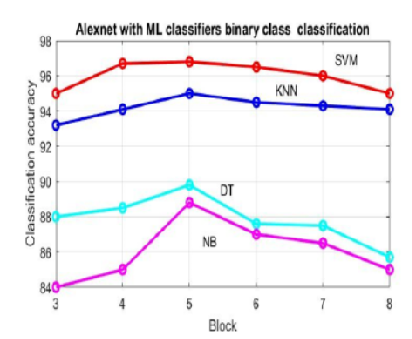


Indian Journal of Science and Technology
DOI: 10.17485/IJST/v16i38.1888
Year: 2023, Volume: 16, Issue: 38, Pages: 3303-3315
Original Article
D L Asha Rani1*, P Anishiya2, T Pramananda Perumal3
1Presidency College, Chennai, 600 005, Tamil Nadu, India
2Anna University, CEG Campus, Guindy, Chennai, 600 025, Tamil Nadu, India
3Presidency College, Chennai, 600 005, Tamil Nadu, India
*Corresponding Author
Email: [email protected]
Received Date:28 July 2023, Accepted Date:13 September 2023, Published Date:17 October 2023
Objectives: The main objective of this work is to detect Covid-19 in radiological chest X-ray images, using Convolutional Neural Network (CNN) as a feature extractor and classify the CNN block-wise features extracted using an ensemble of Machine Learning (ML) classifiers. The classifications of radiological (chest X-ray) images into binary class (Covid-19 and Non-Covid-19) and multi-class (Lungs infected by Covid-19, Normal Lungs and Lungs infected by Pneumonia) are performed in this work. Methods: The various six CNN pre-trained models viz. AlexNet, GoogleNet, VGG-16, ResNet-50, SqueezeNet and Inception-V3 and our proposed CoronaNet model are used for feature extraction. Four most popular ML classifiers such as Support Vector Machine (SVM), K-Nearest Neighbours (KNN), Decision Tree (DT) and Naive-Bayes (NB) are used to classify the features extracted from each of the CNN pre-trained and proposed CoronaNet models. The public dataset of chest X-ray images, created by Joseph Paul Cohen and retrieved from GitHub (Covid-19 - Chest X-ray images dataset) is used in our research work. In total, 3785 training samples, 1686 validation samples and 150 testing samples are used in this work. Findings: The comparative analysis shows that the proposed CoronaNet model with SVM ML classifier has achieved the highest classification accuracy of 97.7% for binary class classification and 96.6% for multi-class classification. Novelty: Exhaustive block wise analysis of the CNN features from the six most popular CNN pre-trained models and the proposed CoronaNet model shows that extracted features in the last layer of each preceding block of CNN models + SVM classifier have resulted in improved classification accuracies, when it is compared to that in the FC /Pool10 layer of CNN models + SVM or Softmax classifier.
Keywords: CNN Deep learning, Machine Learning, Feature extraction, Chest X-ray Images Classification, Covid-19
© 2023 Rani et al. This is an open-access article distributed under the terms of the Creative Commons Attribution License, which permits unrestricted use, distribution, and reproduction in any medium, provided the original author and source are credited. Published By Indian Society for Education and Environment (iSee)
Subscribe now for latest articles and news.